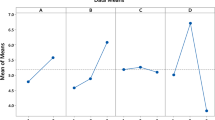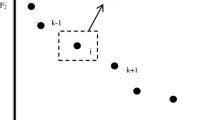Abstract
Electro-discharge machining is an extensively used process for machining of hard-to-cut materials. The process necessitates a conducting tool electrode; however, selection of right material for preparing the tool continues to remain an engineering challenge. This work makes use of a hybrid intelligent algorithm for selecting the right electrode out of three tool electrodes such as composite tool manufactured by laser sintering process (AlSi10Mg), copper and graphite for efficient electro-discharge machining of Ti6Al4V. The work began by constructing a Taguchi’s L27 experimental design and then collecting the output data such as the material removal rate, tool wear rate, surface roughness, surface crack density, white layer thickness and micro-hardness. A multi-objective optimization is proposed to maximise the work piece material removal rate while minimize the remaining output responses. For this purpose, a hybrid grey-TOPSIS based quantum-behaved particle swarm optimization is chosen. Additional data gathered from scanning electron microscopy and energy dispersive spectroscopy techniques reveal new insights into the post-machining material behaviour such as the use of graphite electrode makes the machined surface far harder due to the dissociated carbon.






Similar content being viewed by others
References
Shabgard M, Khosrozadeh B (2017) Investigation of carbon nanotube added dielectric on the surface characteristics and machining performance of Ti–6Al–4V alloy in EDM process. J Manuf Process 25:212–219. https://doi.org/10.1016/j.jmapro.2016.11.016
Dewangan S, Gangopadhyay S, Biswas CK (2015) Multi-response optimization of surface integrity characteristics of EDM process using grey-fuzzy logic-based hybrid approach. Eng Sci Technol Int J 18:361–368. https://doi.org/10.1016/j.jestch.2015.01.009
Uhlmann E, Bergmann A, Bolz R, Gridin W (2018) Application of additive manufactured tungsten carbide tool electrodes in EDM. Proc CIRP 68:86–90. https://doi.org/10.1016/j.procir.2017.12.027
Stucker BE, Bradley WL, Norasetthekul S, Eubank PT (1995) The production of electrical discharge machining electrodes using SLS: preliminary results, International Solid Freeform Fabrication Symposium.
Czelusniak T, Amorim FL, Higa CF, Lohrengel A (2014) Development and application of new composite materials as EDM electrodes manufactured via selective laser sintering. Int J Adv Manuf Technol 72:1503–1512. https://doi.org/10.1007/s00170-014-5765-z
Liu C, Goel S et al (2019) Benchmarking of several material constitutive models for tribology, wear, and other mechanical deformation simulations of Ti6Al4V. J Mech Behav Biomed Mater 97:126–137. https://doi.org/10.1016/j.jmbbm.2019.05.013
Stolf P, Paiva JM et al (2019) The role of high-pressure coolant in the wear characteristics of WC-Co tools during the cutting of Ti–6Al–4V. Wear 440–441:203090. https://doi.org/10.1016/j.wear.2019.203090
Bhaumik M, Maity K (2018) Effect of different tool materials during EDM performance of titanium grade 6 alloy. Eng Sci Technol Int J 21:507–516. https://doi.org/10.1016/j.jestch.2018.04.018
Opoz TT, Yasar H, Ekmekci N, Ekmekci B (2018) Particle migration and surface modification on Ti6Al4V in SiC powder mixed electrical discharge machining. J Manuf Process 31:744–758. https://doi.org/10.1016/j.jmapro.2018.01.002
Kumar S, Batish A, Singh R, Singh TP (2015) A mathematical model to predict material removal rate during electric discharge machining of cryogenically treated titanium alloys. Proc Inst Mech Eng Part B: J Engneering Manuf 229(2):214–228. https://doi.org/10.1177/0954405414527955
Sivam SP, Michaelraj AL, Satish KS, Varahamoorthy R, Dinakaran D (2012) Effects of electrical parameters, its interaction and tool geometry in electric discharge machining of titanium grade 5 alloy with graphite tool. Proc Inst Mech Eng Part B: J Eng Manuf 227(1):119–131. https://doi.org/10.1177/0954405412466213
Sivam SP, Michaelraj AL, Satish KS, Prabhakaran G, Dinakaran D, Ilankumaran V (2014) Statistical multi-objective optimization of electrical discharge machining parameters in machining titanium grade 5 alloy using graphite electrode. Proc Inst Mech Eng Part B: J Eng Manuf 228(7):736–743. https://doi.org/10.1177/0954405413511073
Gohil V, Puri YM (2018) Statistical analysis of material removal rate and surface roughness in electrical discharge turning of titanium alloy (Ti-6Al-4V). Proc Inst Mech Eng Part B: J Eng Manuf 232(9):1603–1614. https://doi.org/10.1177/0954405416673104
Kolli M, Kumar A (2017) Surfactant and graphite powder–assisted electrical discharge machining of titanium alloy. Proc Inst Mech Eng Part B: J Eng Manuf 231(4):641–657. https://doi.org/10.1177/0954405415579019
Sahu AK, Mahapatra SS (2019) Optimization of electrical discharge machining of titanium alloy (Ti6Al4V) by grey relational analysis based firefly algorithm. In: AlMangour B (ed) Additive manufacturing of emerging materials. Springer, Cham, pp 29–53
Czelusniak T, Amorim FL, Lohrengel A, Higa CF (2014) Development and application of copper–nickel zirconium diboride as EDM electrodes manufactured by selective laser sintering. Int J Adv Manuf Technol 72:905–917. https://doi.org/10.1007/s00170-014-5728-4
Amorim FL, Lohrengel A, Schafer G, Czelusniak T (2013) A study on the SLS manufacturing and experimenting of TiB2-CuNi EDM electrodes. Rapid Prototyp J 19(6):418–429. https://doi.org/10.1108/RPJ-03-2012-0019
Amorim FL, Lohrengel A, Neubert V, Higa CF, Czelusniak T (2014) Selective laser sintering of Mo-CuNi composite to be used as EDM electrode. Rapid Prototyp J 20(1):59–68. https://doi.org/10.1108/RPJ-04-2012-0035
Amorim FL, Lohrengel A, Müller N, Schäfer G, Czelusniak T (2013) Performance of sinking EDM electrodes made by selective laser sintering technique. Int J Adv Manuf Technol 65:1423–1428. https://doi.org/10.1007/s00170-012-4267-0
Durr H, Pilz R, Eleser NS (1999) Rapid tooling of EDM electrodes by means of selective laser sintering. Comput Ind 39:35–45
Meena VK, Nagahanumaiah (2006) Optimization of EDM machining parameters using DMLS electrode. Rapid Prototyp J, 12(4):222–228. https://doi.org/10.1108/13552540610682732
Zhao J, Li Y, Zhang J, Yu C, Zhang Y (2003) Analysis of the wear characteristics of an EDM electrode made by selective laser sintering. J Mater Process Technol 138:475–478. https://doi.org/10.1016/S0924-0136(03)00122-5
Tang Y, Fuh JYH, Lu L, Wong YS, Loh HT, Gupta M (2002) Formation of electrical discharge machining electrode via laser cladding. Rapid Prototyp J 8(5):315–319. https://doi.org/10.1108/13552540210451787
Tay FEH, Haider EA (2001) The potential of plating techniques in the development of rapid EDM tooling. Int J Adv Manuf Technol 18:892–896
Rashid WB, Goel S, Davim JP, Joshi SN (2016) Parametric design optimization of hard turning of AISI 4340 steel (69 HRC). Int J Adv Manuf Technol 82:451–462. https://doi.org/10.1007/s00170-015-7337-2
Deng JL (1989) Introduction to grey system theory. J Grey Syst 1:1–24
Datta S, Mahapatra SS (2010) Modeling, simulation and parametric optimization of wire EDM process using response surface methodology coupled with grey-Taguchi technique. Int J Eng Sci Technol 2(5):162–183
Mohanty CP, Satpathy MP, Mahapatra SS, Singh MR (2018) Optimization of cryo-treated EDM variables using TOPSIS-based TLBO algorithm. Sadhana 43(51):1–18. https://doi.org/10.1007/s12046-018-0829-7
Jadidi O, Hong TS, Firouzi F, Yusuff RM (2009) An optimal grey based approach based on TOPSIS concepts for supplier selection problem. Int J Manag Sci Eng Manag 4(2):104–117
Nyaoga R, Magutu P, Wang M (2016) Application of Grey-TOPSIS approach to evaluate value chain performance of tea processing chains. Decision Sci Lett 5:431–446
Sadeghi M, Razavi SH, Saberi N (2013) Application of Grey TOPSIS in preference ordering of action plans in balanced scorecard and strategy map. Informatica 24(4):619–635
Kennedy J, Eberhart R (1995) Particle swarm optimization. In: Proceedings of ICNN'95 - International conference on neural networks, Perth, WA, Australia, 4:1942–1948. https://doi.org/10.1109/ICNN.1995.488968.
Mohanty CP, Mahapatra SS, Singh MR (2016) A particle swarm approach for multi-objective optimization of electrical discharge machining process. J Intell Manuf 27:1171–1190. https://doi.org/10.1007/s10845-014-0942-3
Sun J, Feng B, Xu W (2004) Particle swarm optimization with particles having quantum behavior. In: Proceedings of the 2004 congress on evolutionary computation (IEEE Cat. No.04TH8753), Portland, OR, USA, 1:325–331. https://doi.org/10.1109/CEC.2004.1330875.
Nayak BB, Mahapatra SS (2015) A quantum behaved particle swarm approach for multi-response optimization of WEDM process. In: Panigrahi B, Suganthan P, Das S. (eds) Swarm, evolutionary, and memetic computing. SEMCCO 2014. Lecture Notes in Computer Science, Springer, Cham, 8947:62–73. https://doi.org/10.1007/978-3-319-20294-5_6
Mohanty CP, Mahapatra SS, Singh MR (2017) An intelligent approach to optimize the EDM process parameters using utility concept and QPSO algorithm. Eng Sci Technol Int J 20:552–562. https://doi.org/10.1016/j.jestch.2016.07.003
Omkar SN, Khandelwal R, Ananth TVS, Naik GN, Gopalakrishnan S (2009) Quantum behaved Particle Swarm Optimization (QPSO) for multi-objective design optimization of composite structures. Expert Syst Appl 36:11312–11322. https://doi.org/10.1016/j.eswa.2009.03.006
Acknowledgements
Marco Leite would like to acknowledge the support provided by FCT, through IDMEC, under LAETA, Project UIDB/50022/2020. Saurav Goel greatly acknowledges the financial support provided by the UKRI via Grant No. EP/T001100/1 and EP/T024607/1 and Royal Academy of Engineering for assisting with the Grant No. IAPP18-19\295 and TSP1332.
Author information
Authors and Affiliations
Corresponding author
Additional information
Technical Editor: Adriano Fagali de Souza.
Publisher's Note
Springer Nature remains neutral with regard to jurisdictional claims in published maps and institutional affiliations.
Rights and permissions
About this article
Cite this article
Sahu, A.K., Mahapatra, S.S., Leite, M. et al. A hybrid Grey-TOPSIS based quantum behaved particle swarm optimization for selection of electrode material to machine Ti6Al4V by electro-discharge machining. J Braz. Soc. Mech. Sci. Eng. 44, 188 (2022). https://doi.org/10.1007/s40430-022-03494-y
Received:
Accepted:
Published:
DOI: https://doi.org/10.1007/s40430-022-03494-y




